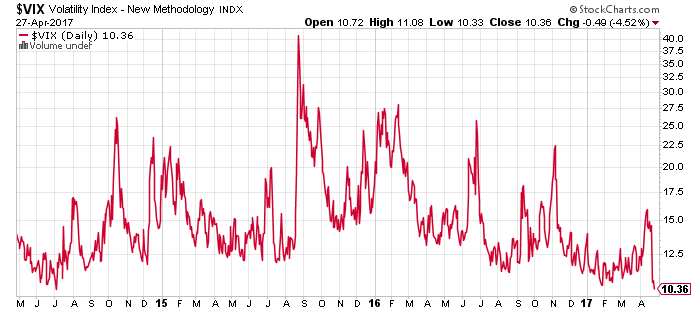Fear Takes A Holiday As VIX Index Falls To 3-Year Low
The VIX Index – a widely followed measure of US stock market volatility — slid to a three-year low on Thursday (Apr. 28), suggesting that investors are unusually serene these days when it comes evaluating the outlook for risk. In fact, investor sentiment has almost never been calmer, according to the VIX. The all-time low for the so-called fear index, which dates to 1990, is 9.48 on Dec. 23, 1993, based on daily data. Considering recent history, it wouldn’t be surprising to see the VIX touch a new record low in the days ahead.
What’s driving the market’s peaceful, easy feeling? Maybe it’s a function of expectations (reasonable or not) that President Trump’s economic policies will triumph and growth will eventually ramp up. But the case for making such a leap of faith rests on thin ice if the administration’s record to date is a guide.
(Click on image to enlarge)

Some critics of the White House charge that the President’s first 100 days have been a “failure” and the “worst on record.” Presidential biographer David McCullough agrees, saying that the administration’s start is the “worst ever” in US history. Fortune lists “7 Economic Promises President Trump Kept in His First 100 Days,” although minds will differ on whether this inventory provides the basis for optimism on the US economic outlook.
In any case, the stock market has no complaints — the S&P 500 closed near an all-time high yesterday. In fact, the financial bliss isn’t limited to equities. A strategist at Bank of America Merrill Lynch wrote in a note to clients on Thursday that “our derivatives strategy team recently noted that several asset classes were pricing a ‘world almost free of risk’ ”.
The placid mood seems a bit strange if you’ve been reading about the Trump’s comments on the potential for war on the Korean peninsula. “There is a chance that we could end up having a major, major conflict with North Korea. Absolutely,” the President told Reuters yesterday. The stakes are high, of course, given that North Korea is armed to the teeth, including nuclear weapons. “We’d love to solve things diplomatically but it’s very difficult,” the President says. Not exactly the traditional basis for a bull market, but the crowd has apparently revised its thinking.
Meanwhile, today’s first-quarter GDP report is expected to deliver a disappointing round of growth. Econoday.com’s consensus forecast sees output rising by 1.1%, roughly half the pace in the previous quarter.
But hope springs eternal and the collective wisdom of the crowd has decided to lift equity prices to within a hair of an all-time record while cutting the risk profile via the VIX to a level that’s close to the lowest level in more than two decades. By that standard, skeptics and bears are woefully misguided.
“If history is a reliable guide, the sudden and sharp decline in the CBOE Volatility Index—or VIX—suggests a few more weeks of stock-market strength,” advises Michael Kahn, a former director for the Market Technicians Association who’s authored several books on analyzing the market with technical analysis.
Whether that’s an accurate forecast or not, another analyst recommends taking advantage of the low risk readings of late by hedging “with VIX futures on the cheap.” The Vix Trader notes that “the VIX June contract provides the best exceptional value, as volatility for such a long-term period has rarely been this cheap.” The author, reportedly a trader/analyst at an undisclosed hedge fund, reasons:
While the stock market roars again as the world enjoys a relief rally after the French elections, a lot of trouble still lingers above and under the surface. It is true the French election results are positive, and U.S. earnings look bullish. However, Europe isn’t out of the woods yet. Concerns about the economy are spreading, North Korea is unpredictable, and Trump’s impulsive decision-making process can lead to a catastrophe at any minute. Any of the above issues have the capacity to create an avalanche in the markets, especially at the current lofty valuations where the market is trading.
As for the VIX, let’s keep in mind that extremely low volatility tends to be a temporary affair. That doesn’t mean that equity prices are destined to crash or that vol is about to spike. But the cyclical history of the VIX shouldn’t be dismissed lightly.
To be fair, volatility also has a habit of clustering, which is to say that low- and high-vol regimes can stick around for a while.
For most investors, however, the only thing that matters is the state of their portfolios. If your US equity allocation is well above target, which wouldn’t be surprising at this late date, there’s a good case for rebalancing and taking risk exposure down a notch.
Sure, the market could go higher from here. Short-term momentum indicators imply as much. But prudent risk management isn’t designed to maximize return; rather, it’s all about boosting the probability of earning a reasonable return through time. Easy to say, tough to do, for the usual reasons – two in particular: fear and greed. At the moment, the former’s in retreat and the latter’s on a roll. Translated: the case for rebalancing is looking pretty good at the moment.
Disclosure: None.



